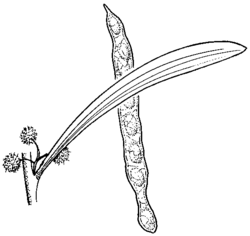Common name: yarran
Acacia homalophylla A.Cunn. ex Benth. APNI* Synonyms: Acacia omalophylla A.Cunn. ex Benth. APNI*
Racosperma omalophyllum (Benth.) Pedley APNI*

Description: Erect or spreading tree or shrub to 7 m high; often suckering; branchlets angled at extremities, glabrous or minutely appressed-hairy between angles on new growth.
Phyllodes narrowly elliptic or oblanceolate to ± linear, straight to slightly curved, 4–11 cm long, usually 4–7 mm wide (range: 3–13 mm wide), sometimes ± glaucous, at first usually minutely appressed-hairy, becoming ± glabrous, longitudinal veins numerous, obscure, sometimes 3 or more slightly more prominent, apex ± obtuse to acute; 1 gland at base; pulvinus 1.5–3 mm long.
Inflorescences 1–3 in axil of phyllodes or on an axillary axis to 2 mm long or sometimes to 15 mm; peduncles 2–5 mm long, minutely hairy; heads globose, usually 20–30-flowered, 4–6 mm diam., bright yellow.
Pods ± straight, ± flat except slightly raised over seeds, barely or slightly constricted between seeds, to 7 cm long, mostly 3–5 mm wide (sometimes up to 7 mm wide), firmly papery to thinly leathery, ± minutely hairy; seeds longitudinal to somewhat oblique; funicle filiform or expanded towards seed.
Flowering: usually August–October, sometimes November.
Distribution and occurrence: west of Emmaville and Muswellbrook. Common in Belah, Rosewood and box communities, in solonized brown earths.
NSW subdivisions: NWS, CWS, SWS, NWP, SWP, ?NFWP, ?SFWP
Other Australian states: Qld Vic.
Very similar to Acacia melvillei, which differs mainly in its thinner, wider pods with transverse to slightly oblique seeds. The name probably refers to the smoothness of the phyllodes which are flat and often appearing ± veinless. Bentham, when publishing this species, used the spelling 'omalophylla' which he corrected to 'homalophylla' in his Flora of Australiense in 1864. The former spelling is used by some botanists and authors.
Text by P.G. Kodela (last updated Mar 2012)
Taxon concept: P.G. Kodela & G.J. Harden, Flora of NSW Vol. 2 (2002)
APNI* Provides a link to the Australian Plant Name Index (hosted by the Australian National Botanic Gardens) for comprehensive bibliographic data
***The AVH map option provides a detailed interactive Australia wide distribution map drawn from collections held by all major Australian herbaria participating in the Australian Virtual Herbarium project.
|


